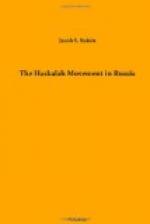[Footnote 25: Ha-Shahar, x. 44-52; FKN, p. 33; Ha-Boker Or, i. 145-146.]
[Footnote 26: FSL, p. 164.]
[Footnote 27: See Guenzburg, Ha-Debir, Warsaw, 1883, ii. 55; Israelitische Annalen, 1840, p. 263.]
[Footnote 28: Ha-Zeman (monthly), iii. 10.]
[Footnote 29: Minor, op. cit, p. 46; Lerner, Yevreyi v Novorossiskom Kraye, Odessa, 1901, p. 234; Monatsschrift, xviii. 234 f., 477 f., 551 f.]
[Footnote 30: Voskhod, 1881, i-iii; Ha-Zeman (monthly), iii. 11-14.]
[Footnote 31: Op. cit, pp. 208-209.]
[Footnote 32: Cf. Graetz, xi. 50; Kayserling, op. cit, p. 288; Fuenn, Sofre Yisrael, Vilna, 1891, pp. 138-143; WMG, p. 135.]
[Footnote 33: Graetz, xi. 590, 604, 606; Annalen, xx. 467; Kayserling, op. cit., p. 307; Landshut, Toledot Anshe Shem, p. 85.]
[Footnote 34: [Hebrew: Yd Tshlhu ’l Rm’’d Bsfri]. Weiss, Zikronotai, p. 58, n.; Ha-Zeman (monthly), i. and iii. 18-19.]
[Footnote 35: Zweifel, op. cit., pp. 35-40, and Ha-Hasidut we-ha-Musar in Ha-Meliz, 1897; Toledot Mishpehot Shneersohn, in Ha-Asif, v. 35-40, and Nefesh Hayyim, iii. 3.]
[Footnote 36: Mandelkern, Dibre Yeme Russyah, iii. 98; American Israelite, nos. 15, 18, etc. (My Travels in Russia); Gordon, Ha-Azamot ha-Yebashot, Odessa, 1899; AZJ, 1854, p. 22; Zunser, Biography, New York, 1905, pp. 15-19 (Engl. transl., pp. 14-18); Shenot Ra’inu Ra’ah, in Ha-Meliz, 1860; Sefer ha-Shanah, iii. 82-101, and GMC, nos. 43-50. One of these songs runs as follows:
On the streets in tears we’re wading,
In our bairns’ blood we might be
bathing;
What a misfortune, ah, wellaway—
Will never dawn the better day?
Little infants from heder are torn,
And forced to wear the soldier’s
uniform;
What a misfortune, etc.
Our leaders, rabbis, and honored elders,
E’en help to impress them for the
czar’s soldiers;
What a misfortune, etc.
Seven sons has Zushe Rakover,
Yet not a one for the army is over;
What a misfortune, etc.
Leah, the widow, has an only son,
And for the kahal’s sins he’s
gone;
What a misfortune, etc.]
[Footnote 37: GMC, no. 42. On similar enthusiasm among the Galician Maskilim, see Erter, Kol Kore, in Ha-Zofeh le-Bet Yisrael, Warsaw, 1890, pp. 131-133.]
[Footnote 38: Elk, Die juedischen Kolonien in Russland, Frankfort-on-the-Main, 1886, pp. 28-53, 60-80, 119-140, 153-160, 205-208; Jastrow, Beleuchtungen, etc., Hamburg, 1859, pp. 109-113.]
[Footnote 39: See Zunz, Gesammelte Schriften, Berlin, 1875, pp, 279-290; Jost, Freimuethige Beleuchtung, Berlin, 1830; and Culturgeschichte, pp. 302-303.]
[Footnote 40: Rabinovitz, op. cit., pp. 11-18.]
[Footnote 41: On Volozhin, see Ha-Kerem, 1887, pp. 67-77; Bikkurim, 1865, pp. 6-45; Ozar ha-Sifrut, iii.; Ha-Asif, iii.; Ha-Meliz, 1900, nos. 16-18; Schechter, op. cit., i. 93-98; Horowitz, Derek ’Ez ha-Hayyim, Cracow, 1895. The yeshibah was reopened under the deanship of Rabbi Raphael Shapira of Bobruisk, and still exists, though in a rather precarious condition.]




